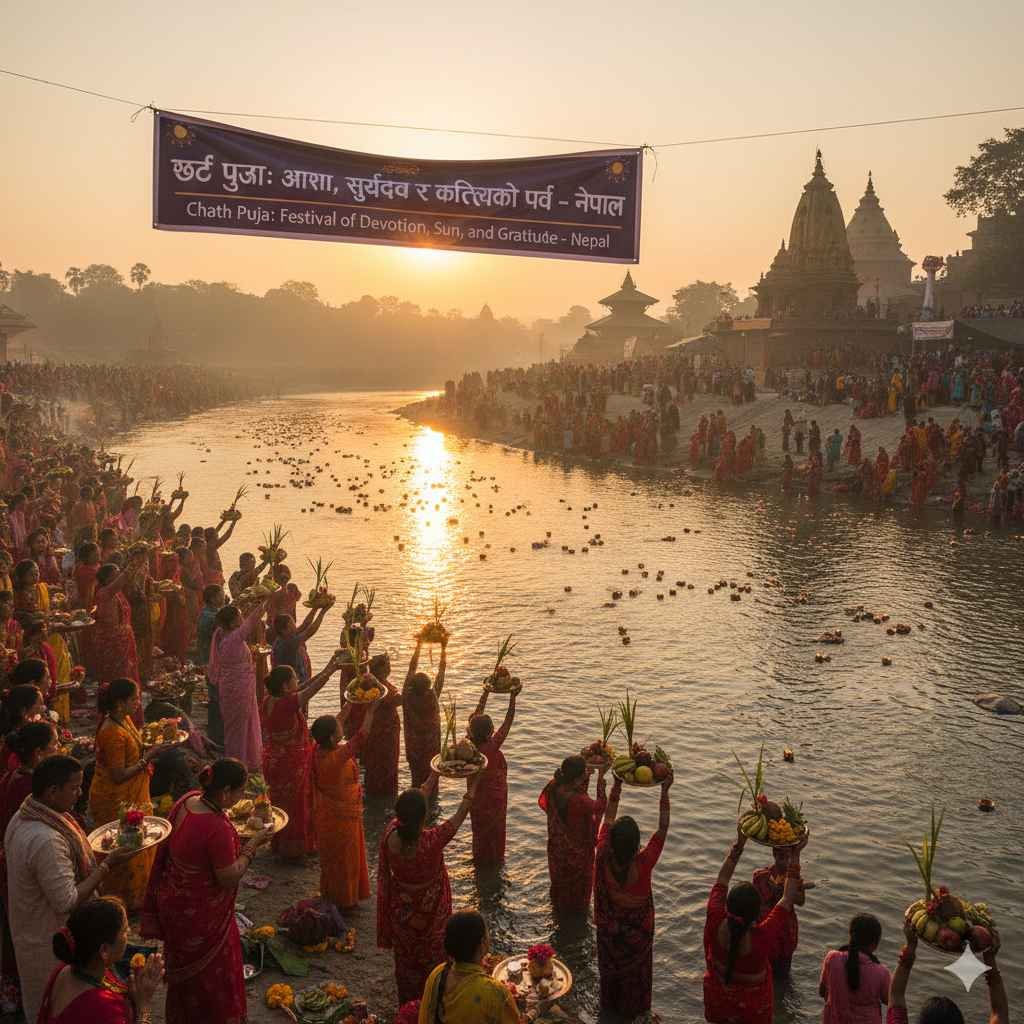
Chhath Puja
Among the most spiritually uplifting festivals celebrated in Nepal and India, Chhath Puja holds a special place in the hearts of millions. Known as Chhat Parva in Nepali, this ancient festival is a divine expression of gratitude toward Surya Dev (the Sun God) and Chhathi Maiya (the Goddess of Power and Prosperity).
Chhath Festival (Chhath Parva) is a four-day Hindu festival that celebrates purity, discipline, and devotion. It is observed mainly in Nepal’s Terai region and the Indian states of Bihar, Jharkhand, and Uttar Pradesh, where devotees gather along rivers and ponds to offer prayers to the setting and rising sun.
In Nepal, Chhath Puja is celebrated with immense enthusiasm, particularly in cities like Janakpur, Birgunj, Biratnagar, and Lahan, where thousands of devotees come together to honor the divine light that sustains all life.
The Significance of Chhath Puja
The word “Chhath” means “sixth,” as the festival falls on the sixth day of the lunar month of Kartik. The core essence of Chhath Puja lies in thanking the Sun God for sustaining life on Earth and seeking his blessings for health, prosperity, and happiness.
In Hinduism, the Sun is regarded as the symbol of energy and life. Devotees believe that offering prayers during Chhath Puja purifies the mind and body and brings divine energy into one’s life.
This festival is also unique because it involves no idol worship. Instead, devotees offer Arghya (holy water and offerings) directly to the Sun, showcasing the simplicity and purity of the tradition.
Chhath Puja 2025 Date and Nepali Calendar
In 2025, Chhath Puja 2025 will be celebrated on 27 October 2025, which corresponds to 10 Kartik 2082 in the Nepali calendar.
Thus, the Chhath Puja Nepali date 2082 is an important occasion that marks the transition from the festive month of Dashain and Tihar to another deeply spiritual event in the Hindu calendar.
During this period, devotees fast, clean their surroundings, and prepare for the rituals with great dedication and discipline.
Chhath Puja Celebrated in Which State?
If you’re wondering “Chhath Puja celebrated in which state?”, the answer extends beyond one region. While it originated in Bihar, the celebration has now spread to Jharkhand, Uttar Pradesh, and parts of West Bengal in India, as well as southern Nepal’s Terai region.
In Nepal, Chhath Puja is most prominently celebrated in Madhesh Province, especially in Janakpur, the birthplace of Goddess Sita. The ponds and ghats (riverbanks) of Janakpur, Birgunj, and Rajbiraj are illuminated with oil lamps, as devotees sing devotional songs throughout the night.
The cross-border cultural connection makes Chhath Puja a symbol of unity and shared faith between Nepal and India.
The Four Days of Chhath Festival (Chhath Parva)
Chhath Festival (Chhath Parva) is a four-day Hindu festival, each day holding deep spiritual meaning and discipline. Here’s a breakdown of each day’s significance:
1. Nahay Khay (Day 1)
The first day marks the beginning of purity. Devotees take a ritual bath in rivers or ponds and prepare vegetarian meals cooked on a clay stove using mango wood. The food is offered to the deity and consumed only after the offering.
2. Lohanda and Kharna (Day 2)
On the second day, devotees observe a day-long fast that ends after sunset with kheer (rice pudding) and fruits. This ritual symbolizes self-control and devotion.
3. Sandhya Arghya (Day 3)
This is the most significant evening of Chhath Puja, where devotees gather at riverbanks to offer Arghya to the setting sun. The ghats glow with thousands of lamps, creating a magical and serene atmosphere.
4. Usha Arghya (Day 4)
The final morning of Chhath Puja involves offering prayers to the rising sun. Devotees break their fast and pray for prosperity, health, and happiness for their families.
Chhath Puja Dress Code for Women
One of the most beautiful aspects of Chhath Puja is its traditional attire. The Chhath Puja dress code for women usually includes wearing sarees in shades of red, orange, or yellow, which symbolize purity, energy, and devotion.
Women often cover their heads with a pallu (veil) as a mark of respect and modesty. The sarees are usually made of silk or cotton, decorated with golden borders. Men generally wear dhoti-kurta or simple traditional attire.
These traditional outfits not only enhance the festive spirit but also maintain the sanctity and discipline that the festival emphasizes.
Rituals and Offerings During Chhath Puja
The rituals of Chhath Puja are deeply symbolic. Devotees prepare Thekua (a sweet made from wheat flour, ghee, and jaggery) and offer it along with fruits like sugarcane, coconut, and banana.
All offerings are placed in bamboo baskets, emphasizing the eco-friendly nature of this ancient celebration. The rituals highlight a harmonious connection between humans and nature an essence deeply rooted in Nepalese and Indian tradition.
Chhath Puja in Nepal: Faith Along the Ghats
In Nepal, Chhath Puja is celebrated mainly in the Madhesh region, where devotees gather along ponds and rivers such as Ganga Sagar in Janakpur, Bagmati in Sarlahi, and Sirsiya in Birgunj.
Women sing traditional songs like “Kanchhi Hey Chhathi Maiya” and spend the night in devotion. The atmosphere becomes surreal as people offer prayers, light oil lamps, and express gratitude to nature.
Chhath Puja in Nepal also signifies cultural unity, as both Hindus and non-Hindus participate with equal enthusiasm.
Spiritual Symbolism and Environmental Message
Beyond religious devotion, Chhath Puja carries an important environmental message. The rituals encourage cleanliness of rivers, use of natural ingredients, and respect for nature.
This eco-conscious tradition is an ancient example of sustainable celebration one where devotion meets environmental responsibility.
Chhath Puja 2025: A Modern Celebration of Ancient Faith
As Chhath Puja 2025 approaches, people across Nepal and India are preparing to celebrate this festival with even more enthusiasm. Social media platforms are filled with pictures of ghats, traditional songs, and family gatherings.
Despite modern lifestyles, the essence of Chhath Puja remains unchanged a heartfelt offering of gratitude, purity, and connection with nature.
Why Chhath Puja Matters Today
In today’s fast-paced world, Chhath Puja reminds us to pause and appreciate the natural forces that sustain us. The Sun giver of light and life becomes a symbol of hope, energy, and renewal.
For communities in Nepal, especially in the Terai, it’s not just a festival; it’s a celebration of culture, discipline, and gratitude.
Frequently Asked Questions (FAQ) about Chhath Puja
1. What is Chhath Puja?
Chhath Puja is a Hindu festival dedicated to the Sun God and Chhathi Maiya, celebrated to thank them for sustaining life on Earth.
2. Chhath Festival (Chhath Parva) is a four-day Hindu festival — what happens each day?
Each day symbolizes purification, fasting, and worship: Nahay Khay, Lohanda & Kharna, Sandhya Arghya, and Usha Arghya.
3. When is Chhath Puja 2025?
Chhath Puja 2025 will be celebrated on 27 October 2025, corresponding to 10 Kartik 2082 in the Nepali calendar.
4. Chhath Puja celebrated in which state?
It is mainly celebrated in Bihar, Jharkhand, Uttar Pradesh, and Nepal’s Terai region.
5. What is the Chhath Puja dress code for women?
Women traditionally wear red or yellow sarees with golden borders, representing devotion and purity.
6. What are the main offerings during Chhath Puja?
Thekua, fruits, sugarcane, and coconut are offered in bamboo baskets to the Sun God.
Chhath Puja stands as a timeless festival of faith, purity, and gratitude. Whether celebrated along the Ganga Sagar in Janakpur or the Ghats of Bihar, the devotion remains the same an unbroken connection between humans and the divine light.
As Chhath Puja 2025 approaches on 10 Kartik 2082 (27 October 2025), may the Sun’s rays bring warmth, prosperity, and positivity to every home.
Let this Chhat Parva remind us to live in harmony with nature, cherish our traditions, and pass this legacy of devotion to the next generation. 🌞🙏

